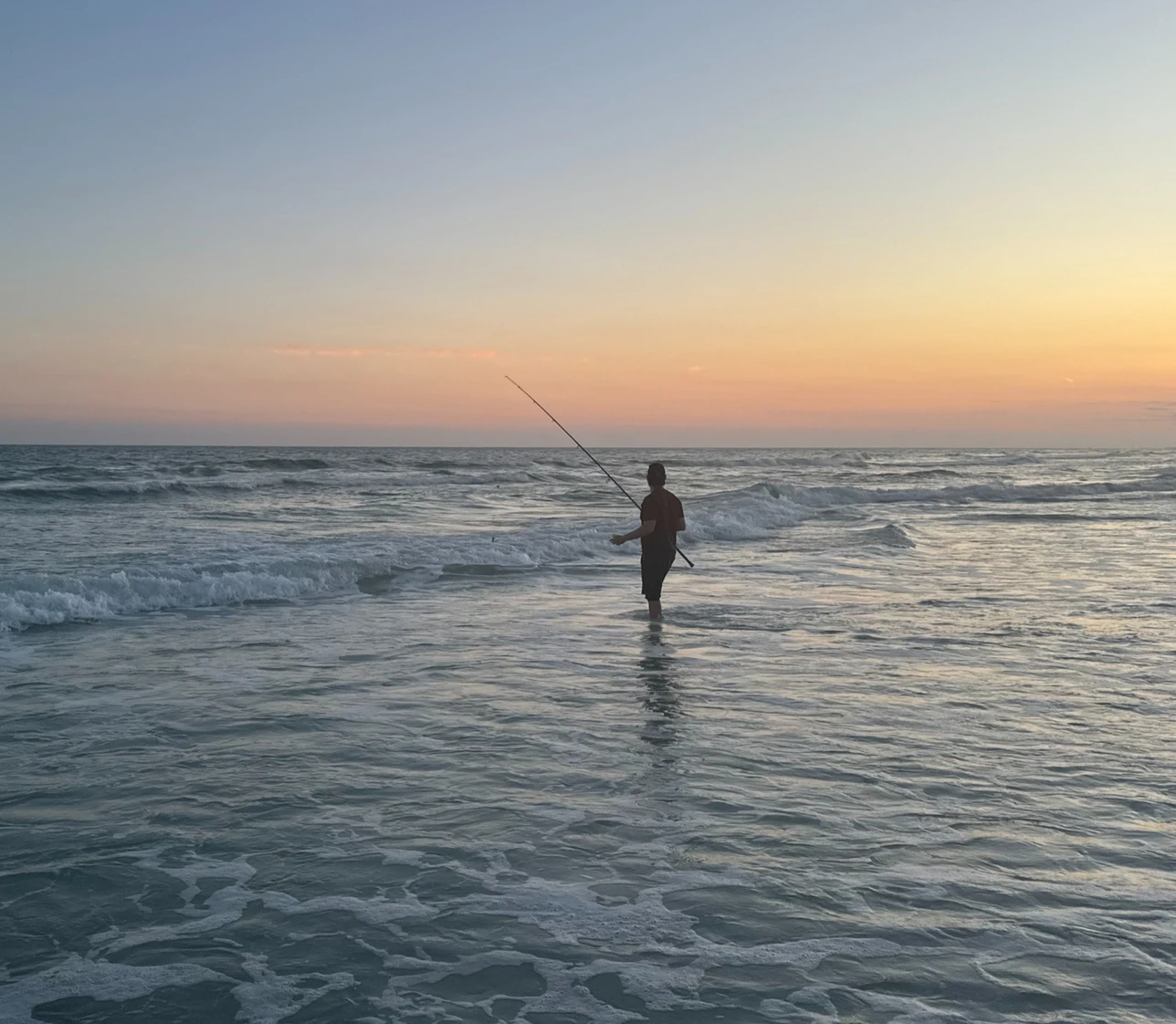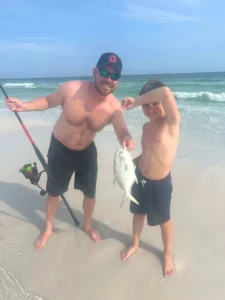
I have found that timing is everything when surf fishing. The trouble is that I typically fish when my family goes to the beach. My schedule is determined by my kid’s ability to prepare for a day at the ocean, not when the best bite occurs. As I roll my cart onto the sand, I often see other anglers leaving. I’ll ask – did you catch anything? And I’m surprised the amount of times I hear people say, “No, I didn’t catch anything.”
Conventional wisdom says that as the sea moves into High Tide, this is the best time to fish the beach. But truly, timing the bite is much more complicated than that. Sunlight, water temperature, time of year, current, structure, UV exposure, air pressure, moon phases, and tides impact the fishing activity. If you are like me, you are not a biologist and accounting for all these factors is overwhelming. Thankfully, there are free tools that do the work for you. To determine the best time of day to surf fish, I have found that when multiple favorable conditions align, I have the greatest chances of catching fish. When tidal movement, low-light conditions, and high fish activity, as reported by fishingreminder.com or tides4fishing.com, all coincide around the same time, I find that I have the best chances for success catching fish.
Best Time to Surf Fish New Tools: Use a Fishing App
No one in their right mind uses an atlas to travel the country. Nowadays, you simply type in wherever you want to go into your GPS and it finds the fastest route and often even avoids traffic. We should think about fishing in the same way. Sure, you can fish dawn, dusk, or the tidal movement, but you may be missing out on the best times to fish.
I first check fishingreminder.com to see if it’s a poor, fair, good or great day to fish. In my book every day is a great day to fish, but this tool tells you when your chances of catching fish are probable or not. Choosing the right day is just as important as choosing the right time of day. Once I’ve figured out what day to fish, I will check and see what the most optimal time to fish for that day is. Fishingreminder.com breaks down the best times to fish into major and minor times. The major times identify when the fish are most active and the minor times are supposed to be the second-best times for fishing activity. When I have control of my schedule, I plan for good or great days during the major times.
These fishing apps use solar patterns to predict the best fish activity, but I find that the best fishing is right before a low pressure system (rain). If there are a few stable days of weather, the fish get into a rhythm. A low pressure system will disrupt that rhythm. They tend to gorge themselves right before the rain comes. Hands down my favorite time to fish is right before a storm. For this reason, your favorite weather app may be your best fishing app.
Dawn, Dusk, or Midday – Which is the Best Time to Fish?
Let’s say your app tells you it’s a “great day” to fish—but your schedule says otherwise. If you can’t hit the major activity windows, your next best bet is dawn or dusk. These low-light windows are prime time for fish to feed. The sun’s just creeping up (or fading out), baitfish are cruising the shallows, and predators are in ambush mode.
Why does it work? Fish—like redfish, stripers, pompano—take full advantage of low UV exposure and better camouflage in dim light. That means more confidence, more movement, and more bites.
If I had to pick one time of day with no tide data, moon phases, or apps—I’d pick sunrise every time. You’ll get more action in 90 minutes of early morning tide movement than three hours of casting at high noon while kids are boogie boarding through your rig.
🎣 Bonus Tip: If you’re stuck fishing mid-day, at least fish during an incoming tide. And fish deep—look for cuts, holes, or troughs where fish hunker down to avoid sunburn. Just like you.
🌊Finding the Best Tide to Surf Fish: Tides + Time = Bite Windows
If low light is the curtain drop for feeding time, tide movement is the stage crew behind the scenes making sure the whole show happens. You can fish the prettiest sunrise of the year, but if the water’s dead still, don’t be surprised if your line is too.
Tides control everything in surf fishing—where the bait goes, where the fish go, and whether anything is actually moving around to eat your perfectly presented shrimp.
Fishing the Incoming Tide: The Sweet Spot
Surf fishing the incoming tide is the gold standard. As the tide rises along the beach, water pushes baitfish, shrimp, and crabs closer to shore—and predators follow. It also floods structure like sandbars, troughs, and cuts, making fish feel comfortable enough to feed in the shallows. The incoming tide also increases the depth of the first two beach troughs, which provide beach anglers ability to cast into deeper pools of water. While fishing the incoming tide pulls fish towards the beach, I recommend locating rip currents to fish. Rip currents pull sand fleas, crabs, and other bait into the troughs where predator fish are waiting to feed. Pinpointing your bait near this feeding frenzy will increase your chances of a bite.
High Tide: Mixed Bag
High tide can be great if it lines up with sunrise or sunset. But it can also mean fish are more spread out. They’re not pinned in tight—they’ve got options. It’s like fishing a buffet instead of a food truck.
🎯 Look for features like points, jetties, or drop-offs that concentrate bait even when the tide is high.
Falling Tide: Still Worth It
As water pulls back, bait gets flushed out of the shallows. Fish often stage in deeper cuts and troughs, waiting to pick off easy meals being swept out with the current. This is a good time to fish around outflows, creek mouths, and anywhere with visible movement. Its the same logic for fishing rip currents. As the tide goes out, it pulls bait with it. Rivers and inner coastal channels that fill up with bait are now being sucked out to the ocean. This can provide great opportunities to fish these channels.
🎯 Use rigs that keep your bait in the strike zone longer—like fish finder or Carolina rigs with enough weight to stay put.
Low Tide: Tough but Useful
Low tide is usually slow unless you’re scouting. There’s less water, less bait, and more beachgoers asking you, “Catching anything?” But it’s a great time to walk the beach and mark structure: troughs, cuts, holes, sandbars—the fish highways for later when the tide comes in.
🎯 Bring a camera or take mental notes. What you find at low tide will help you fish smarter during prime hours.
🧠 Put It All Together
Look, you can fish at noon during slack tide with a cooler full of warm beer and hope for the best. But if you want to actually catch fish—not just get some “casting practice”—you’ve got to think like a predator.
That means:
- Showing up when the light is low
- Fishing when the water’s moving
- Using free apps so you’re not guessing like it’s 1998
The truth is, the best time of day to surf fish isn’t always convenient—but it is predictable. If you line up sunrise or sunset with a rising tide and a decent activity window from your app, your odds go way up. And the best part? You don’t need a PhD in marine biology—just a smartphone and a willingness to wake up before the beach crowd shows up with inflatable unicorns.
🐟 Want More? Get the Inside Scoop
If you found this helpful (or at least mildly entertaining), you’ll love the newsletter. I share real-time surf fishing tips, seasonal patterns, gear picks, and hard-won lessons from the beach—so you can fish smarter and catch more, even if you’ve only got a two-hour window between family sunscreen reapplications.
📬 Subscribe now and get insider fishing info delivered right to your inbox. No spam, just fishing.
👉 Insider Surf Fishing Info - Subscribe Now!
Tight lines and good timing. See you on the beach—hopefully on an incoming tide
.Do you need a new Surf Fishing Rod? Check out my buying guide for the Best Surf Fishing Rod and Reel Combo.



0 Comments